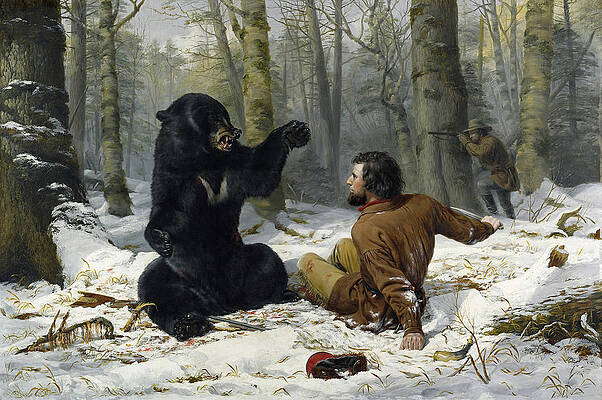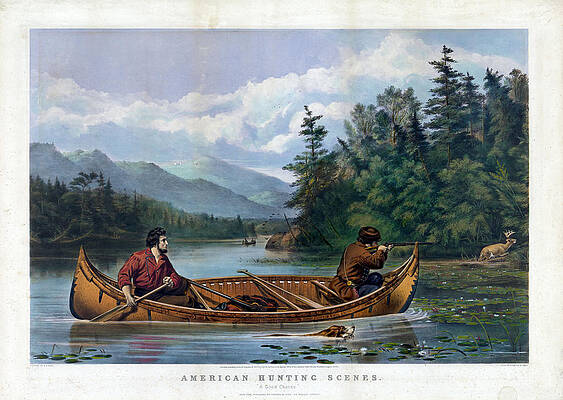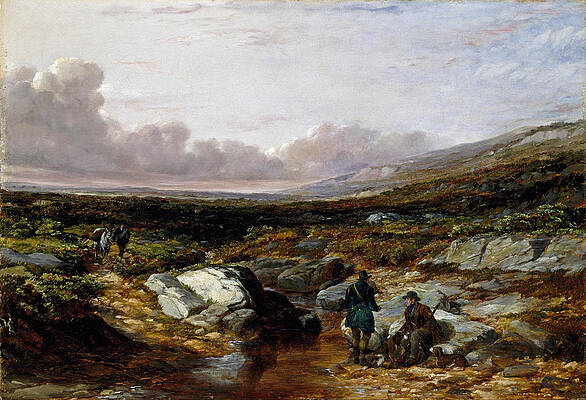Arthur Fitzwilliam Tait
American hunting scenes
Flushing Grouse. Long Lake. Hamilton County New York
Tait Hen Quail And Chickens
A Slight Chance. A Good Chance
An Anxious Moment
Maternal Solicitude
Maternal Solicitude
Deer Stalking in Scotland. Getting Ready
The Reprimand. Ah you Naughty Fawnyou have been eating the flowers again
Doe and Fawns




American Wood Duck and Golden Eye

Amos F. Adams Shooting Over Gus Bondher and Son, Count Bondher














Down the road in Franklin County New York






Flushed Ruffed Grouse Shooting


Hunting on the Scottish Highlands



Mink Trapping in Northern New York

Misty Morning on the Hudson River















The Life of a Hunter A Tight Fix








Arthur Fitzwilliam Tait (February 5, 1819 – April 28, 1905) was a British artist who is known mostly for his paintings of wildlife.[1] During most of his career, he was associated with the New York City art scene.
Life and career
Tait was born in Lively Hall near Liverpool, England. At eight years old, because his father went bankrupt he was sent to live with relatives in Lancaster. It is during that time that he became attached to animals. Later on, in Manchester, England, Agnew & Zanetti Repository of Art acquired Arthur Tait who began self-learning to paint, as a twelve-year-old boy.[2] His work consisted mostly of reproduced lithography that were exposed for Agnew's exhibitions. In 1838, he left the Agnew lithography reproduction business to marry.[3]
Life on the Prairie, The Buffalo Hunt, Arthur Fitzwilliam Tait, lithograph by Currier & Ives, 1862
During the late 1840s he became aware of the Americas while attending a George Catlin exhibition in Paris.[4] He immigrated to the United States in 1850, where he established a small painting camp in the Adirondacks to paint during summer. Starting in 1852, Currier & Ives reproduced lithographies of his works to publicize him. What also promoted his talent was exhibitions held at the National Academy of Design, New York during the late 19th century showing more than 200 paintings of his. In 1858 he was elected to full membership of the Academy.[2]
Tait's "The Reprimand" (1852), at the Brooklyn Museum in New York City shows a rural girl "warning" a deer.
He was identified with the art life of New York until his death at Yonkers, New York in 1905. He painted barnyard fowl and wild birds as well as sheep and deer, with great dexterity, and reproductions of his minute panels of chickens had an enormous vogue.[5]
In 2006, Tait's painting Good Hunting Ground: The Home of the Deer was auctioned for $167,300.
References
American Art Annual, Volume 5. MacMillan Company. 1905. p. 124.
Chisholm, Nan, Noelle DeSantis & James L. Halperin. Heritage Galleries & Auctioneers American Art Signature Auction #604, Heritage Capital Corporation. p. 11. ISBN 1-932899-31-6.
"Arthur Fitzwilliam Tait". Russell Fink Gallery. Retrieved 2006-07-11.
"Arthur Fitzwilliam Tait". The National Museum of Wildlife Art. Retrieved 2006-07-11.[dead link]
Chisholm 1911.
Attribution
This article incorporates text from a publication now in the public domain: Chisholm, Hugh, ed. (1911). "Tait, Arthur Fitzwilliam". Encyclopædia Britannica 26 (11th ed.). Cambridge University Press.
----
Fine Art Prints | Greeting Cards | Phone Cases | Lifestyle | Face Masks | Men's , Women' Apparel | Home Decor | jigsaw puzzles | Notebooks | Tapestries | ...
----
Artist
A - B - C - D - E - F - G - H - I - J - K - L - M -
N - O - P - Q - R - S - T - U - V - W - X - Y - Z
Retrieved from "http://en.wikipedia.org/"
All text is available under the terms of the GNU Free Documentation License













